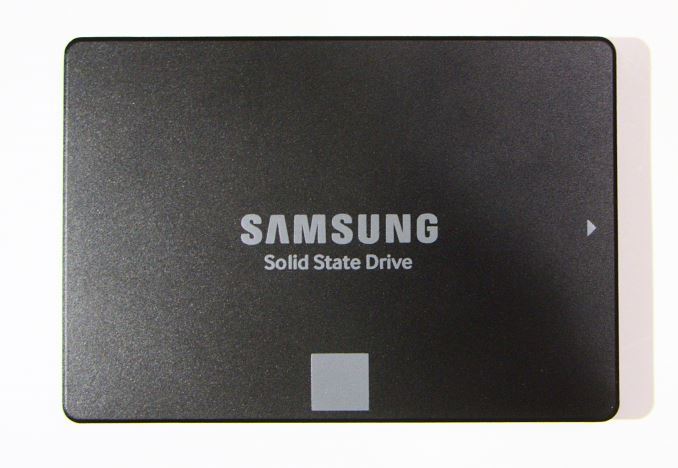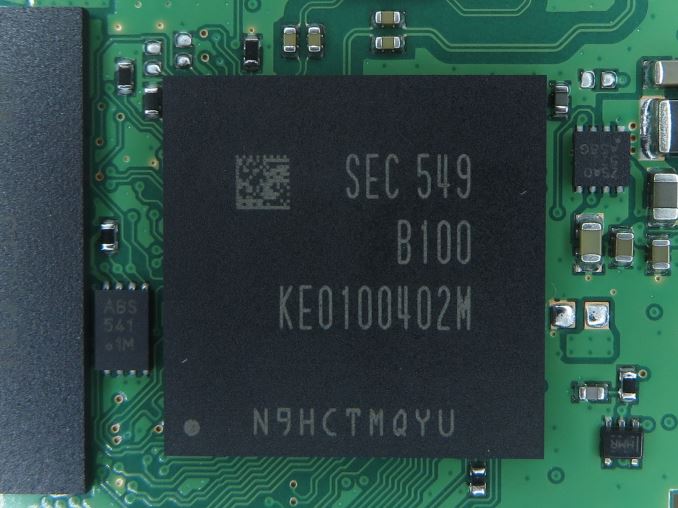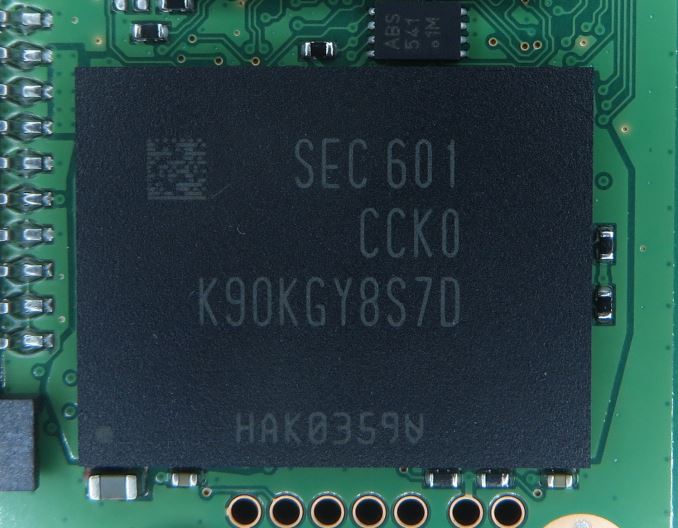The Samsung 750 EVO (120GB & 250GB) SSD Review: A Return To Planar NAND
by Billy Tallis on April 22, 2016 8:00 AM EST
Since the introduction of their first consumer TLC SSD with the SSD 840, Samsung's consumer/retail SATA SSD lineup has consisted of two product families: the MLC-based Pro drives, and the TLC-based 840 and EVO drives. The strength of Samsung's SSD controllers and the advantages of 3D NAND have allowed the 850 EVO to maintain a solidly mid-range position in the SSD market well above any other drive using TLC NAND.
Meanwhile, with the strength of the 850 EVO as a near-midrange product - and with pricing to match - like so many other vendors over the last year, Samsung has also been developing a true low cost TLC drive for the mass market. The end result is the Samsung 750 EVO, which we're revieiwng today. The 750 EVO establishes a new budget-oriented product line that competes in the cutthroat low end of the market where price per GB is the most important aspect of the product.
There are several design choices that help minimize the cost of the 750 EVO, aside from the obvious choice of TLC over MLC. The MGX controller it borrows from the lower capacity 850 EVOs is a dual-core version of Samsung's usual triple-core architecture. Similarly, the 750 EVO is only available in 120GB and 250GB sizes, so there is no high-priced high capacity model. Consequently, with only two small capacities, the 750 EVO line is served by a single tiny PCB layout, made even smaller by the fact that Samsung has put the 256MB of DRAM in the same package as the SSD controller.

Samsung MGX controller with onboard 256MB DRAM
But the most significant aspect of the 750 EVO is that it doesn't use the 3D NAND that has been a key competitive advantage for Samsung's 850 product lines. Samsung has continued development of planar NAND even after transitioning their retail SSDs to 3D NAND, and the 750 EVO in turn uses 16nm planar TLC. It doesn't offer the same performance or endurance of Samsung's 3D NAND, but it does significantly lower the cost of the drive.

128GB of 16nm TLC NAND in a single package
The 16nm TLC NAND is the successor to Samsung's 19nm TLC that had a troubled tenure in the 840 EVO. With the 840 EVO, data at rest on the drive degraded over time and eventually required the use of more thorough and thus slower error correction when read back. As a result the 750 EVO inherits the benefits of all the firmware work Samsung did to mitigate the read speed degradation. This, for what it's worth, gives Samsung some degree of a leg-up against other 16/15nm TLC drives that face the same challenges.
| Samsung TLC SATA SSD Comparison | |||||
| Drive | 750 EVO 120GB | 750 EVO 250GB | 850 EVO 120GB | 850 EVO 250GB | |
| Controller | MGX | MGX | |||
| NAND | Samsung 128Gb 16nm TLC | Samsung 32-layer 128Gbit TLC V-NAND | |||
| DRAM | 256MB | 256MB | 256MB | 512MB | |
| Sequential Read | 540MB/s | 540MB/s | 540MB/s | 540MB/s | |
| Sequential Write | 520MB/s | 520MB/s | 520MB/s | 520MB/s | |
| 4KB Random Read | 94K IOPS | 97K IOPS | 94K IOPS | 97K IOPS | |
| 4KB Random Write | 88K IOPS | 88K IOPS | 88K IOPS | 88K IOPS | |
| 4KB Random Read QD1 | 10K IOPS | 10K IOPS | 10K IOPS | 10K IOPS | |
| 4KB Random Write QD1 | 35K IOPS | 35K IOPS | 40K IOPS | 40K IOPS | |
| DevSleep Power | 6mW | 2mW | |||
| Slumber Power | 50mW | 50mW | |||
| Active Power (Read/Write) | 2.1W / 2.4W (Average) | 2.4W / 2.8W (Average) | Max 3.7W / 4.4W | ||
| Encryption | AES-256, TCG Opal 2.0, IEEE-1667 (eDrive) | AES-256, TCG Opal 2.0, IEEE-1667 (eDrive) | |||
| Endurance | 35TB | 70TB | 75TB | ||
| Warranty | Three years | Five years | |||
By and large the performance specifications for the 750 EVO match the lower capacity 850 EVO, though a slightly lower random write speed at a queue depth of one hints that the 750 EVO may require a bit more background wear leveling work. The feature set is identical to the 850 EVO, making the 750 EVO one of the few low-end drives to support TCG Opal encryption.
Samsung's marketing strategy for the 750 EVO is a little different from their previous retail SSD products. The 750 EVO is targeted specifically at system integrators and system builders, rather than at users looking to upgrade an existing machine. Consequently, they aren't pushing to make the 750 EVO available from as wide a range of retail outlets. Enough of the major online retailers have it in stock that it is not difficult to obtain.
This review will focus on comparing the 750 EVO against Samsung's other SATA SSDs and against other current-generation low-end TLC SSDs of comparable capacity. Our Bench tool can assist in making other comparisons.
| AnandTech 2015 SSD Test System | |
| CPU | Intel Core i7-4770K running at 3.5GHz (Turbo & EIST enabled, C-states disabled) |
| Motherboard | ASUS Z97 Pro (BIOS 2701) |
| Chipset | Intel Z97 |
| Memory | Corsair Vengeance DDR3-1866 2x8GB (9-10-9-27 2T) |
| Graphics | Intel HD Graphics 4600 |
| Desktop Resolution | 1920 x 1200 |
| OS | Windows 8.1 x64 |
- Thanks to Intel for the Core i7-4770K CPU
- Thanks to ASUS for the Z97 Deluxe motherboard
- Thanks to Corsair for the Vengeance 16GB DDR3-1866 DRAM kit, RM750 power supply, Carbide 200R case, and Hydro H60 CPU cooler










109 Comments
View All Comments
Sn3akr - Monday, April 25, 2016 - link
8$ is just too little of a difference and will not make a difference in a build as such.. I only see this as being implemented in finished machines from manufacturers, so that they can pop another 8$ in their pocket. Aftermarket.. Doubt it will sell a lot.Maybe i would use it in a HTPC, since it's not something that requires a lot of R/W operations once it's booted up
slowdemon21 - Thursday, April 28, 2016 - link
I noticed PNY & OCZ BENCHED IN THE MIDDLE, Sammy on the bottom [loser]Ahmad kassem - Sunday, May 1, 2016 - link
Is it ok to make more than one partition on this ssd or any other ssd?wayneclaassen - Thursday, May 5, 2016 - link
Well I needless to say I found the Samsung EVO 250GIG extremely reliable although it is a bit expensive, but for anyone that mostly run high performance graphics this price tag shouldn't be a big problem.Bulat Ziganshin - Saturday, May 7, 2016 - link
1. 750 may be a hit for developing markets. in particular i've seen 750 reviews on russian sites much earlier than here:fcenter/online/hardarticles/hdd/38770-Samsung_SSD_zadeshevo_obzor_Samsung_650_i_Samsung_750_EVO
2. Can you please add to your reviews checks of gc/trim effect and slc cache size as in the section
3dnews/931062/page-2.html#Деградация%20и%20восстановление%20производительности
eduard.fisic - Sunday, June 5, 2016 - link
Billy, when you guys run the benchmarks, are the Samsung Evo drives run with RAPID Mode on or off? Just out of curiosity, as I am looking to buy the 850 Evo and I'd like to know if I can expect this sort of performance without having to turn on RAPID Mode. Thanks!jason_brody - Thursday, July 7, 2016 - link
Can anyone help if I should go with this SSD or 850 series for my Dell E6500?elzafir - Tuesday, April 11, 2017 - link
The 250GB 840 EVO is $15 cheaper where I live compared to the 750 EVO of the same size. Which one should I get?Manisthisunreal - Friday, October 13, 2017 - link
Notice because of all the fatmouths saying they'll "wait until it is cheaper" the industry has now colluded to up the prices and make up some bs excuses of "low demand" "commodity trader speculation on minerals". Yes we can blame stock traders for a lot of things like high oil prices, high wheat and other food goods prices but come on I smell something fishy. I was about to buy a 250gb Samsung SSD on black Friday for $60 almost two years ago when some idiot shopper woman decided to merge into me when I was on my way home from work leading to a 15 month nightmare. I never did make it out to get my ssd. Fast forward almost 2 years later and they've doubled in price. I really wanted that.